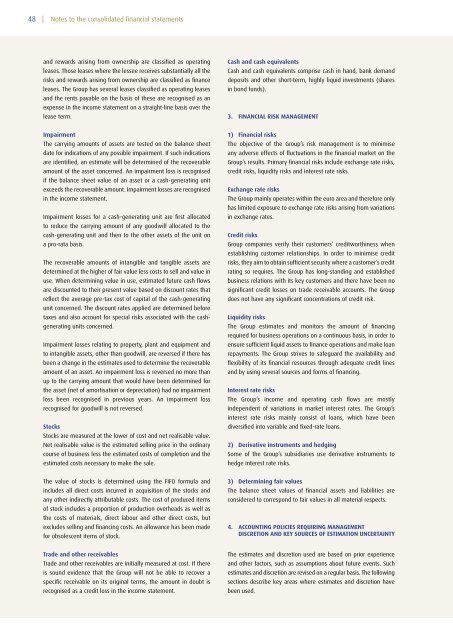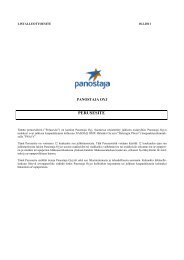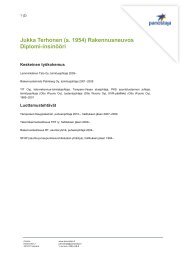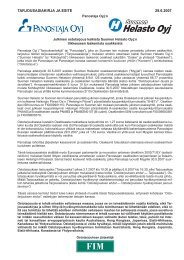Annual Report 2007 - Panostaja
Annual Report 2007 - Panostaja
Annual Report 2007 - Panostaja
You also want an ePaper? Increase the reach of your titles
YUMPU automatically turns print PDFs into web optimized ePapers that Google loves.
48 |<br />
Notes to the consolidated financial statements<br />
and rewards arising from ownership are classified as operating<br />
leases. Those leases where the lessee receives substantially all the<br />
risks and rewards arising from ownership are classified as finance<br />
leases. The Group has several leases classified as operating leases<br />
and the rents payable on the basis of these are recognised as an<br />
expense in the income statement on a straight-line basis over the<br />
lease term.<br />
Cash and cash equivalents<br />
Cash and cash equivalents comprise cash in hand, bank demand<br />
deposits and other short-term, highly liquid investments (shares<br />
in bond funds).<br />
3. FINANCIAL RISK MANAGEMENT<br />
Impairment<br />
The carrying amounts of assets are tested on the balance sheet<br />
date for indications of any possible impairment. If such indications<br />
are identified, an estimate will be determined of the recoverable<br />
amount of the asset concerned. An impairment loss is recognised<br />
if the balance sheet value of an asset or a cash-generating unit<br />
exceeds the recoverable amount. Impairment losses are recognised<br />
in the income statement.<br />
Impairment losses for a cash-generating unit are first allocated<br />
to reduce the carrying amount of any goodwill allocated to the<br />
cash-generating unit and then to the other assets of the unit on<br />
a pro-rata basis.<br />
The recoverable amounts of intangible and tangible assets are<br />
determined at the higher of fair value less costs to sell and value in<br />
use. When determining value in use, estimated future cash flows<br />
are discounted to their present value based on discount rates that<br />
reflect the average pre-tax cost of capital of the cash-generating<br />
unit concerned. The discount rates applied are determined before<br />
taxes and also account for special risks associated with the cashgenerating<br />
units concerned.<br />
Impairment losses relating to property, plant and equipment and<br />
to intangible assets, other than goodwill, are reversed if there has<br />
been a change in the estimates used to determine the recoverable<br />
amount of an asset. An impairment loss is reversed no more than<br />
up to the carrying amount that would have been determined for<br />
the asset (net of amortisation or depreciation) had no impairment<br />
loss been recognised in previous years. An impairment loss<br />
recognised for goodwill is not reversed.<br />
Stocks<br />
Stocks are measured at the lower of cost and net realisable value.<br />
Net realisable value is the estimated selling price in the ordinary<br />
course of business less the estimated costs of completion and the<br />
estimated costs necessary to make the sale.<br />
1) Financial risks<br />
The objective of the Group’s risk management is to minimise<br />
any adverse effects of fluctuations in the financial market on the<br />
Group’s results. Primary financial risks include exchange rate risks,<br />
credit risks, liquidity risks and interest rate risks.<br />
Exchange rate risks<br />
The Group mainly operates within the euro area and therefore only<br />
has limited exposure to exchange rate risks arising from variations<br />
in exchange rates.<br />
Credit risks<br />
Group companies verify their customers’ creditworthiness when<br />
establishing customer relationships. In order to minimise credit<br />
risks, they aim to obtain sufficient security where a customer’s credit<br />
rating so requires. The Group has long-standing and established<br />
business relations with its key customers and there have been no<br />
significant credit losses on trade receivable accounts. The Group<br />
does not have any significant concentrations of credit risk.<br />
Liquidity risks<br />
The Group estimates and monitors the amount of financing<br />
required for business operations on a continuous basis, in order to<br />
ensure sufficient liquid assets to finance operations and make loan<br />
repayments. The Group strives to safeguard the availability and<br />
flexibility of its financial resources through adequate credit lines<br />
and by using several sources and forms of financing.<br />
Interest rate risks<br />
The Group’s income and operating cash flows are mostly<br />
independent of variations in market interest rates. The Group’s<br />
interest rate risks mainly consist of loans, which have been<br />
diversified into variable and fixed-rate loans.<br />
2) Derivative instruments and hedging<br />
Some of the Group’s subsidiaries use derivative instruments to<br />
hedge interest rate risks.<br />
The value of stocks is determined using the FIFO formula and<br />
includes all direct costs incurred in acquisition of the stocks and<br />
any other indirectly attributable costs. The cost of produced items<br />
of stock includes a proportion of production overheads as well as<br />
the costs of materials, direct labour and other direct costs, but<br />
excludes selling and financing costs. An allowance has been made<br />
for obsolescent items of stock.<br />
3) Determining fair values<br />
The balance sheet values of financial assets and liabilities are<br />
considered to correspond to fair values in all material respects.<br />
4. ACCOUNTING POLICIES REQUIRING MANAGEMENT<br />
DISCRETION AND KEY SOURCES OF ESTIMATION UNCERTAINTY<br />
Trade and other receivables<br />
Trade and other receivables are initially measured at cost. If there<br />
is sound evidence that the Group will not be able to recover a<br />
specific receivable on its original terms, the amount in doubt is<br />
recognised as a credit loss in the income statement.<br />
The estimates and discretion used are based on prior experience<br />
and other factors, such as assumptions about future events. Such<br />
estimates and discretion are revised on a regular basis. The following<br />
sections describe key areas where estimates and discretion have<br />
been used.











